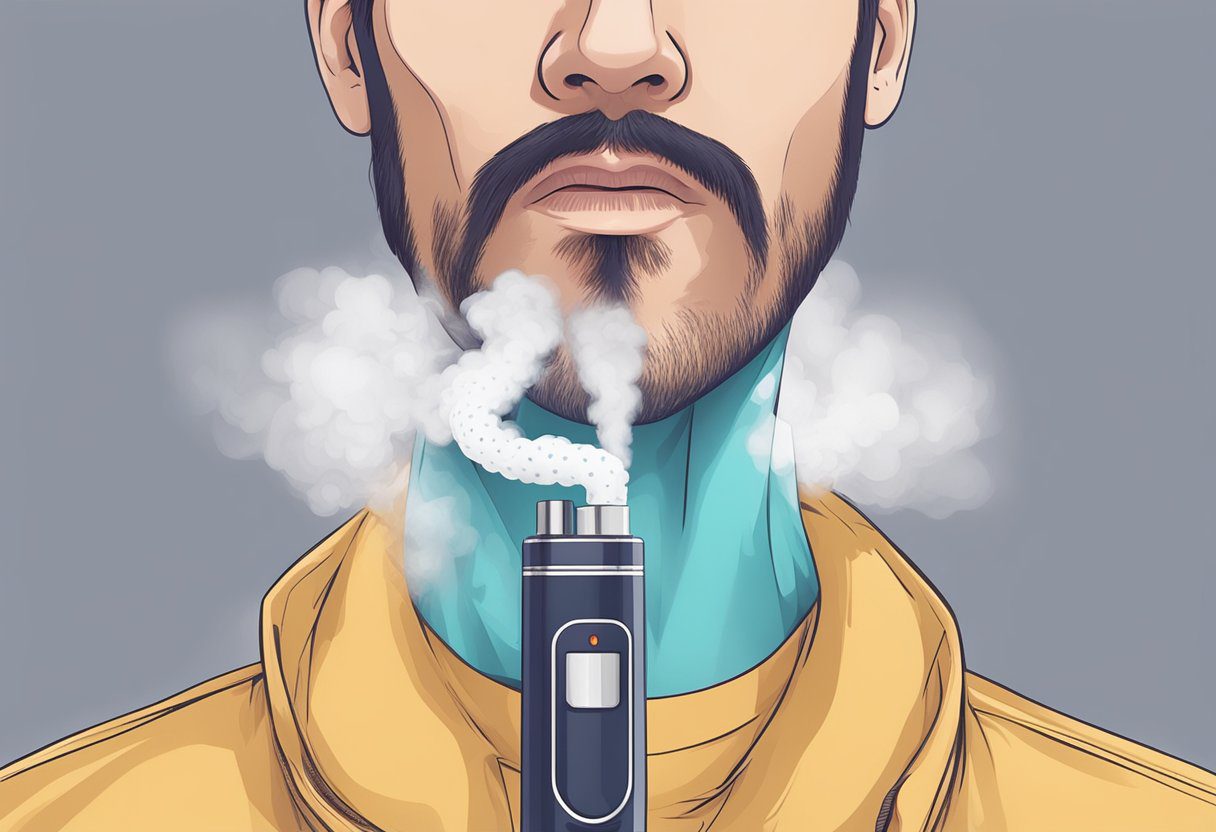Throat Hit vs Lung Hit: How to Vape
Vaping has become a popular alternative to smoking in recent years. It is a method of inhaling smoke-looking vapour from an electronic cigarette or vape device. The vapour is created by heating a flavoured nicotine liquid called vape juice or e-juice, which is then inhaled by the user. One of the key aspects of vaping is the sensation that vapers feel in their throat when they inhale the vapour. This is known as a throat hit and is often compared to the sensation of smoking a traditional cigarette.
There are two main ways to inhale the vapour when vaping: throat hit and lung hit. A throat hit is achieved by holding the vapour in the mouth before inhaling it into the lungs, while a lung hit involves inhaling the vapour directly into the lungs. The type of hit that a vaper prefers depends on their personal preference and vaping style. Some vapers prefer a strong throat hit, while others prefer a smoother lung hit.
Understanding the difference between throat hit and lung hit is important for vapers, especially those who are new to vaping. Knowing how to achieve the desired sensation can enhance the overall vaping experience. In this article, we will explore the differences between throat hit and lung hit, how to achieve each type of hit, and answer some frequently asked questions about vaping.
Key Takeaways
- Throat hit and lung hit are the two main ways to inhale the vapor when vaping.
- The type of hit that a vaper prefers depends on their personal preference and vaping style.
- Understanding the difference between throat hit and lung hit is important for vapers to enhance their overall vaping experience.
Understanding Vaping
Vaping is the act of inhaling and exhaling vapour produced by an electronic device known as a vape. The device heats up a liquid, known as e-liquid or vape juice, to produce the vapour. Vaping is considered an alternative to smoking and has gained popularity over the years due to its perceived health benefits.
The Basics of Vaping
Vaping involves the use of a device that heats up an e-liquid to produce vapour. The device can be a vape pen, box mod, or any other type of device that is designed to work with e-liquids. The e-liquid is stored in a tank or cartridge, and a coil is used to heat up the liquid. The user then inhales the vapour produced by the device.
The Role of E-Liquids
E-liquids come in a variety of flavours and nicotine strengths. The liquid is made up of propylene glycol (PG), vegetable glycerine (VG), flavourings and nicotine. PG is used to produce a stronger throat hit, while VG is used to produce more vapour. The nicotine strength of e-liquids can vary, and users can choose the level of nicotine that suits them best.
Health Implications
While vaping is considered an alternative to smoking, it is not without its health implications. The long-term effects of vaping are still unknown, and there is debate over whether or not vaping is a safer alternative to smoking. However, vaping is generally considered to be less harmful than smoking, as it does not produce tar or carbon monoxide, which are known to cause cancer and stroke.
Media and Vaping
The media has played a significant role in shaping public opinion on vaping. While some media outlets have portrayed vaping as a safer alternative to smoking, others have raised concerns about the health implications of vaping. It is important to note that the media can sometimes exaggerate the risks associated with vaping, and it is important to do your own research before making any decisions.
Understanding Nicotine Salts
Nicotine salts are a type of e-liquid that are becoming increasingly popular among vapers. They are designed to provide a smoother throat hit and are often used by smokers who are trying to quit. Nicotine salts are available in a range of strengths, and users can choose the level of nicotine that suits them best.
Throat Hit vs Lung Hit
When it comes to vaping, two terms that are often heard are “throat hit” and “lung hit.” Understanding the difference between these two types of hits can help vapers choose the right e-liquid and device for their needs and preferences.
What is a Throat Hit?
A throat hit is the sensation that a vaper feels when the vapour hits the back of their throat. It is often described as a tingling or scratching feeling, similar to the sensation of smoking a traditional cigarette. The intensity of the throat hit can vary depending on several factors, including the nicotine level, flavour, PG/VG ratio, and power setting.
The nicotine level is one of the most important factors that affect the throat hit. Higher nicotine levels tend to produce a stronger throat hit, while lower levels result in a smoother hit. The flavour of the e-juice can also impact the throat hit, with menthol and other cooling flavours providing a more pronounced sensation.
The PG/VG ratio is another factor that can affect the throat hit. A higher PG concentration tends to produce a stronger throat hit, while a higher VG concentration results in a smoother hit. The power setting of the device can also impact the throat hit, with higher wattage settings producing a stronger hit.
What is a Lung Hit?
A lung hit, also known as direct-to-lung (DTL) vaping, is when the vapour is inhaled directly into the lungs. This type of vaping is often associated with sub-ohm tanks and high-powered mods, as it requires more power to produce larger clouds of vapour.
The sensation of a lung hit is different from a throat hit, as it is felt in the lungs rather than the throat. The intensity of the lung hit can vary depending on several factors, including the VG concentration, power setting, and airflow setting.
A higher VG concentration tends to produce thicker clouds of vapour, while a higher power setting and airflow setting can increase the intensity of the lung hit. Sub-ohm tanks and high-powered mods are often used for lung hit vaping, as they can produce larger clouds of vapour and provide a more intense hit.
Overall, the choice between a throat hit and a lung hit comes down to personal preferences. Some vapers prefer a stronger throat hit, while others prefer the larger clouds and smoother hit of a lung hit. It is important to experiment with different e-juices, devices, and settings to find the perfect vaping experience for you.
How to Vape
When it comes to vaping, there are a few things to consider before getting started. In this section, we will cover the basics of how to vape, including choosing your equipment, selecting your e-liquid, setting up your vape, and inhaling techniques.
Choosing Your Equipment
Choosing the right equipment is crucial for a good vaping experience. There are many types of devices available, from basic vape pens to advanced box mods. If you’re new to vaping, it’s best to start with a simple device and work your way up.
Sub-ohm tanks are a popular choice for many vapers, as they produce large clouds of vapour and intense flavour. However, they require more power than other types of tanks, so it’s important to select a mod that can handle the extra load.
Selecting Your E-Liquid
E-liquids come in a wide range of flavours, nicotine strengths, and PG/VG ratios. When selecting your e-liquid, consider your personal preferences and vaping style. If you prefer a strong throat hit, choose an e-liquid with a higher PG ratio. For a smoother inhale, opt for an e-liquid with a higher VG ratio.
Setting Up Your Vape
Before you start vaping, you’ll need to set up your device. This includes filling your tank with e-liquid, priming your coil, and adjusting your airflow and power settings. Be sure to follow the manufacturer’s instructions carefully to avoid damaging your device or experiencing a dry hit.
Inhaling Techniques
There are two main inhaling techniques when it comes to vaping: mouth to lung (MTL) and direct to lung (DTL). MTL vaping involves drawing the vapour into your mouth before inhaling it into your lungs. This technique is best for those who prefer a stronger throat hit and a more cigarette-like experience.
DTL vaping involves inhaling the vapour directly into your lungs, bypassing the mouth altogether. This technique is best for those who prefer a smoother inhale and a more intense flavour experience.
In conclusion, vaping can be an enjoyable and satisfying experience when done correctly. By following these basic guidelines, you can select the right equipment, e-liquid, and inhaling technique to suit your personal preferences and vaping style.



Leave a Reply